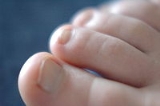
Toe
Overview
Digit (anatomy)
A digit is one of several most distal parts of a limb, such as fingers or toes, present in many vertebrates.- Names:Some languages have different names for hand and foot digits ....
s of the foot
Foot
The foot is an anatomical structure found in many vertebrates. It is the terminal portion of a limb which bears weight and allows locomotion. In many animals with feet, the foot is a separate organ at the terminal part of the leg made up of one or more segments or bones, generally including claws...
of a tetrapod
Tetrapod
Tetrapods are vertebrate animals having four limbs. Amphibians, reptiles, birds and mammals are all tetrapods; even snakes and other limbless reptiles and amphibians are tetrapods by descent. The earliest tetrapods evolved from the lobe-finned fishes in the Devonian...
. Animal
Animal
Animals are a major group of multicellular, eukaryotic organisms of the kingdom Animalia or Metazoa. Their body plan eventually becomes fixed as they develop, although some undergo a process of metamorphosis later on in their life. Most animals are motile, meaning they can move spontaneously and...
species such as cat
Cat
The cat , also known as the domestic cat or housecat to distinguish it from other felids and felines, is a small, usually furry, domesticated, carnivorous mammal that is valued by humans for its companionship and for its ability to hunt vermin and household pests...
s that walk on their toes are described as being digitigrade
Digitigrade
A digitigrade is an animal that stands or walks on its digits, or toes. Digitigrades include walking birds , cats, dogs, and many other mammals, but not plantigrades or unguligrades...
. Human
Human
Humans are the only living species in the Homo genus...
s, and other animals that walk on the soles of their feet, are described as being plantigrade
Plantigrade
right|151px|thumb|Human skeleton, showing plantigrade habitIn terrestrial animals, plantigrade locomotion means walking with the podials and metatarsals flat on the ground. It is one of three forms of locomotion adopted by mammals...
; unguligrade animals are those that walk on hooves
Hoof
A hoof , plural hooves or hoofs , is the tip of a toe of an ungulate mammal, strengthened by a thick horny covering. The hoof consists of a hard or rubbery sole, and a hard wall formed by a thick nail rolled around the tip of the toe. The weight of the animal is normally borne by both the sole...
at the tips of their toes.
The toes are, from medial to lateral:
- HalluxHalluxIn tetrapods, the hallux is the innermost toe of the foot. Despite its name it may not be the longest toe on the foot of some individuals...
("big toe" or "great toe"), the innermost (most proximal) toe and the closest to the toes of the other foot - Second toeLong toeThe long toe or second toe is the second toe distally and is next to the hallux.The second toe has three phalanx bones: the first, middle and third....
or "long toe" (although commonly shorter than the big toe and often the third or fourth toes) - Third toe, occasionally described as the "ring toe"
- Fourth toe, sometimes described as the "ring toe"
- Fifth toeFifth toeThe fifth toe is the outermost and usually the smallest toe of the foot.It is associated with many medical conditions, largely due to the use of shoes....
("little toe", "pinky toe", or "baby toe"), the outermost (most distal) toe
The human foot consists of numerous bones and soft tissues which support the weight of the upright human.
Unanswered Questions

